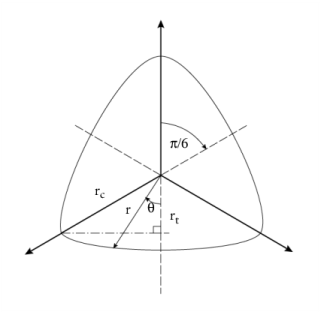The Bresler-Pister criterion (Ref. 2,
Ref. 17) was originally devised to predict the strength of concrete under multiaxial stresses. This failure criterion is an extension of the
Drucker-Prager Criterion to brittle materials, and it can be expressed in terms of the stress invariants as
here, k1,
k2, and
k3 are parameters obtained from the uniaxial compressive strength
σc, the uniaxial tensile strength
σb, and the biaxial compressive strength
σb
The Willam-Warnke criterion (Ref. 10) is used to predict failure in concrete and other cohesive-frictional materials such as rock, soil, and ceramics. Just as the
Bresler-Pister Criterion, it depends only on three parameters. It was developed to describe initial concrete failure under triaxial conditions. The failure surface is convex, continuously differentiable, and it is fitted to test data in the low compression range.
where σc is the uniaxial compressive strength,
σt is uniaxial tensile strength, and
σb is the biaxial compressive strength (all parameters are positive). The octahedral normal and shear stresses are defined as usual; see
Other Stress Invariants
so the criterion in Equation 3-45 can be written in term of stress invariants as
The dimensionless function r(
θ) describes the segment of an ellipse on the octahedral plane as a function of the Lode angle
θ
Here, the tensile and compressive meridian rt and
rc are defined in terms of the strengths
σc,
σb, and
σt:
The function r(
θ) can be interpreted as the friction angle which depends on the Lode angle
θ (
Ref. 10).

Here, σc >
0 is the uniaxial compressive strength of concrete, and
a>0 and
b>0 are dimensionless parameters. The dimensionless function
λ(θ) depends on the Lode angle
θ and the dimensionless parameters
k1 > 0 and
k2 > 0.
The parameter k1 is called the
size factor. The parameter
k2 (also called
shape factor) is positive and bounded to 0
≤ k2 ≤ 1(
Ref. 17,
Ref. 18).
Typical values for these parameters are obtained by curve-fitting the uniaxial compressive strength σc, uniaxial tensile strength
σt, and from the biaxial and triaxial data (for instance, a typical biaxial compressive strength of concrete is 16% higher than the uniaxial compressive strength). The parameters
σc,
σb, and
σt are positive.
where σ1 ≥ σ2 ≥ σ3 ≥ 0 are the principal stresses at failure (as defined in geotechnical engineering; that is, an
absolute value),
σc is the uniaxial compressive strength of the intact rock (positive parameter), and
m and
s are positive material parameters.
with σc,
m, and
s positive material parameters. (In this case, note that
σ1 < sσc/m).
As developed originally, there is no relation between the parameters m and
s and the physical characteristics of a rock mass measured in laboratory tests. However, for intact rock,
s = 1 and
m = mi, which is measured in a triaxial test.
For jointed rock masses, 0 ≤ s
< 1 and
m < mi. The parameter
m usually lies in the range
5 < m < 30 (
Ref. 7).
The generalized Hoek-Brown criterion was developed in order to fit the Geological Strength Index (GSI) classification of isotropic rock masses (Ref. 6). A new relationship between GSI,
m,
s and the newly introduced parameter
a was developed, to give a smoother transition between very poor quality rock masses (GSI
<
25) and stronger rocks
where σ1 ≥ σ2 ≥ σ3 are the principal stresses (using the Structural Mechanics Module conventions) of the
effective stress tensor (this is, the stress tensor minus the fluid pore pressure).
The positive parameter mb is a reduced value of the material constant
mi:
s and
a are positive parameters for the rock mass given by the following relationships:
The disturbance factor D was introduced to account for the effects of stress relaxation and blast damage, and it varies from
0 for undisturbed in situ rock masses to
1 for very damaged rock masses.
